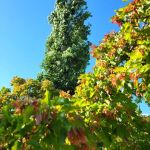Gardening Journeys: Ornamental trees that are both water-wise and fire-resistant
Published 8:35 am Wednesday, June 11, 2025


The Arbor Day tree planting this spring got me thinking about the best attributes for ornamental trees that are hardy for Central Oregon. Hot summers and freezing winters can make it challenging to find a tree that can cope with both scenarios. With several neighborhood wildfires already this summer, some homeowners also have to worry about that. And then there’s the drought and concerns about water scarcity or the cost of the water bill. How can you maximize your budget and find trees that check all the boxes? It is possible, so read on.
Many of us find a pretty tree at a big box store or garden center and fail to consider it’s mature size, much less the implications of that size or the water needs. This includes Master Gardeners!
Here’s an example of one of my poor choices. It pains me now to see beautiful trees such as Leyland Cypress for sale at a big box stores. Pallets of them at a bargain price. These trees may be considered ‘hardy’ for the Willamette Valley, but they are only rated as zone 6 – 10 and require moist soil. Although the USDA zone map shows central Oregon as Zone 6, OSU Extension suggests Zone 5. Leyland’s are known for rapid growth for privacy or a wind break, but their branches are susceptible to breakage under snow loads or in heavy winds. These trees struggle to handle our frigid winters, especially when we have a dry spell. I tried growing one for several years because it’s very pretty, but the large windstorm six years ago took it out, root ball and all. They have shallow roots….They also require regular shearing to maintain shape and size. They are known to require average moisture, but that means regular watering, especially in dry times. I wanted a conifer garden but was happier with the blue spruce.
Ornamental trees that are both water-wise and fire resistant and suited to our climate do exist. Many of them, but they are not conifers. To identify trees that fit the bill, I found two OSU Extension publications:
- ‘Fire-resistant Plants for Home Landscapes,’ publication PNW 590
- ‘Water-wise Gardening in Central Oregon,’ publication EM 91366
Both of these publications are available as .pdf files on the OSU Extension Deschutes website at: https://extension.oregonstate.edu/catalog/pub/pnw-590-fire-resistant-plants-home-landscapes. Hardcopies are also available at the OSU Extension office in Redmond at: Deschutes County, 3800 SW Airport Way, Building #4, Redmond, OR 97756.
The trees on my list all have low water needs but do prefer supplemental irrigation. And they are fire-resistant. Fire-resistant does not mean fireproof. Even fire-resistant plants will burn if they aren’t well maintained with proper pruning and appropriate watering. Fire-resistant means that the plant/or tree will not readily ignite from a flame or other ignition source. Their foliage and stems do not significantly contribute to the fire, they produce fewer embers and do not promote fire. There are more fire-resistant attributes to consider, including branching patterns, amount of dead wood, moisture content, sap and leaf type.
The trees on this list are all hardy to a minimum of zone 4, and four of them can handle full sun. The remaining seven trees prefer full sun to partial shade. The list contains the average height and spread which will assist homeowners to determine the best placement, keeping in mind the yard size and the proximity to the home and power lines.
Six of the varieties, even flower in springtime and all offer fall color. Additional descriptive features follow:
Hawthorn: White or red flowers are showy in spring and are followed by clusters of orange-red berries that attract birds. Select a variety that is thornless.
Honeylocust: The attractive leaves provide filtered shade, and thornless varieties are most desirable.
Red oak: This is a fast-growing oak and has very pointy lobes on the dark-green leaves in summer. Fall colors display tones of red, orange, and reddish brown.
Catalpa: Notable for large, heart-shaped leaves and attractive white flowers in spring which form long seed pods resembling string beans.
Amur maple: This maple has good fall color and is a good choice for a small area.
Hackberry: Striking light-green leaves and unique corky-type bark.
Smoketree: The name derives from it’s hairy flowers which resemble plumes of smoke in summer and fall. The purple-leaved varieties turn a striking red in fall.
Chokecherry: White flowers in spring are followed by edible purple fruits popular for jams and jellies. A variety called ‘Schubert’ has maroon summer leaves. Other varieties possess green leaves.
Crabapple: Due to restrictions in planting crabapples in some regions, I recommend fruitless varieties, which are also less messy. These trees have beautiful flowers in white, pink, rose and even red in springtime.
Serviceberry: The fruits are edible, and it has excellent fall colors of red orange.
Swedish Aspen: Similar to Quaking aspen, the Swedish variety is taller and columnar in shape but also possesses the leaf shape and sound with yellow-orange fall colors. My Swedish Aspen have not suckered very much, which is an added benefit.
To plant your tree: Dig the hole at least two times wider than the tree container and place the tree in the hole so that the soil height in the container is at or above the soil planting depth. After removing the tree from the container, look at the roots and rough them up a little, watching out for roots circling inside the container. Do not plant it without pulling the roots out from the circling pattern. Replace native soil around the tree roots about halfway up and water well to remove air pockets. If you don’t have enough native soil, mix it half and half with potting soil or aged compost. If the native soil is too dry, pre-water in the hole to encourage new root growth. Backfill the rest of the planting hole with native soil and add mulch on top to retain moisture. Pull the mulch away from the tree a couple of inches so you don’t bury the tree collar. Water regularly and deeply until the roots are established. If the tree comes wrapped it burlap, be sure to remove the burlap and string ties. The ties will strangle the tree as it grows, and the burlap can cause the roots to circle rather than spread before the burlap disintegrates in our dry soils.
If the tree is spindly or the site is windy, it may benefit from staking for the first six months to a year, just enough time for the tree to build some stability. Don’t use wire for strapping and allow the tree some movement within the strapping system.
Enjoy your landscape trees. Remember the spring blossoms, summer shade and fall color as you rake the fallen leaves in November.







